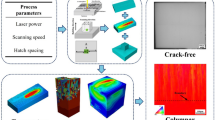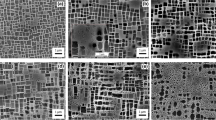Abstract
The mechanical properties of nickel-based superalloys depend strongly on their microstructure, namely the grain size and the state of precipitation. Main design criteria in aeronautical turbine disks are the resistance to disk burst and low cycle fatigue in the bore, but also to creep in the rim part due to higher temperatures. The chosen microstructures result from a compromise between these contradictory requirements. Indeed, creep durability is improved using a coarse grain microstructure while the increase of static and fatigue strength requires a fine grain microstructure. Moreover, the volume fraction and the size distribution of γ′ precipitates are the predominant parameters controlling mechanical properties at lower temperatures. A spatial optimization of the microstructure is reachable using specific technologies, e.g. dual-microstructure heat treatment. The development of microstructure-sensitive models is thus a major concern for the optimal design of these components including gradient of grain size and/ or precipitate size. Full-field finite element simulations may be employed to predict the macroscopic behavior of polycrystalline aggregates using crystal plasticity constitutive equations whose parameters depend explicitly on the microstructural attributes. In this framework, the present study is devoted to the evaluation of the yield stress of polycrystalline AD730TM nickel-based superalloy, chosen as a model material. This work includes microstructural characterization and mechanical tests carried out on single crystals and polycrystalline specimens with well-controlled microstructures. Predictions of the macroscopic yield stress are provided by preliminary simulations carried out in the elastic regime combined with a specific post-processing.
Access this chapter
Tax calculation will be finalised at checkout
Purchases are for personal use only
Similar content being viewed by others
References
Telesman, J et al. (2008) Effect of Microstructure on Time Dependent Fatigue Crack Growth Behavior In a P/M Turbine Disk Alloy. Paper presented at the 11th International Symposium on Superalloys, Seven Springs, Champion, PA, USA, 14–15 September 2008.
Mazière M et al. (2009) Overspeed burst of elastoviscoplastic rotating disks - Part I: Analytical and numerical stability analyses. European Journal of Mechanics A/Solids, 28-36:44. https://doi.org/10.1016/j.euromechsol.2008.07.008.
Larrouy B et al. (2015) Grain boundary - Slip bands interactions: impact on the fatigue crack initiation in a polycrystalline forged Nibased superalloy. Acta Materialia, 99-325:336. https://doi.org/10.1016/j.actamat.2015.08.009.
Connor LD (2009) The development of a dual microstructure heat treated Ni-base superalloy for turbine disc applications. Ph.D. thesis, University of Cambridge. https://www.ethos.bl.uk/OrderDetails.do?uin=uk.bl.ethos.597898.
Bridier, F et al., (2018) Method for heat treating by induction an alloy component for generating microstructure gradients and an alloy component heat treated according to the method. U.S. Patent 2018/0371564 A1. 27 December 2018.
Gabb T et al. (2011) Fatigue resistance of the grain size transition zone in a dual microstructure superalloy disk. International Journal of Fatigue, 33-414:426. https://doi.org/10.1016/j.ijfatigue.2010.09.022.
Taboada Michel H et al. (2016) Mechanical properties of cast & wrought hybrid disks. Paper presented at the 13th International Symposium on Superalloys, At Seven Springs, PA, USA, 11–15 September 2016.
Devaux A et al. (2014) Effect of aging of heat-treatment on mechanical properties of AD730TM superalloy. Paper presented at 8th International Symposium on Superalloy 718 and Derivatives, Pittsburgh, PA, USA, September 28-October 1 2014.
Vaunois JR et al. (2010) Influence of both γ′ distribution and grain size on the tensile properties of UDIMET 720Li at room temperature. Paper presented at 7th International Symposium on Superalloy 718 and Derivatives, Pittsburgh, PA, USA, 10–13 October 2010.
Galindo-Nava E et al. (2015) On the prediction of the yield stress of unimodal and multimodal γ′ Nickel-base superalloys. Acta Materialia, 98-377:390. https://doi.org/10.1016/j.actamat.2015.07.048.
Devaux A et al. (2012) AD730TM - A New Nickel-Based Superalloy for High Temperature Engine Rotative Parts. Paper presented at the 12th International Symposium on Superalloys, Seven Springs, PA, USA, 09–13 September 2012.
Thébaud L et al. (2018) Is there an optimal grain size for creep resistance in Ni-based disk superalloys? Materials Science and Engineering 716(A)-274:283. https://doi.org/10.1016/j.msea.2017.12.104.
Masoumi F et al. (2016) Coarsening and dissolution of gamma’ precipitates during solution treatment of AD730 (TM) Ni-based superalloy: Mechanisms and kinetics models. Journal of Alloys and Compounds 658-981:995. https://doi.org/10.1016/j.jallcom.2015.11.002.
Thébaud L et al. (2015) Relationships between Microstructural Parameters and Time-Dependent Mechanical Properties of a New Nickel-Based Superalloy AD730™. Metals 5:2236–2251. https://doi.org/10.3390/met5042236.
Petch NJ (1953) The cleavage strength of polycrystals. J. Iron Steel Inst. 174-25:28.
Hook RE, Hirth J (1967) The deformation behavior of isoaxial bicrystals of fe-3%Si. Acta Metall. 15-535:551. https://doi.org/10.1016/0001-6160(67)90087-9.
Hashimoto K, Margolin H (1983) The role of elastic interaction stresses on the onset of slip in polycrystalline alpha brass – I. Experimental determination of operating slip systems and qualitative analysis. Acta Metall. 31-773:785. https://doi.org/10.1016/0001-6160(83)90093-7.
Meyers MA, Ashworth E (1982) A model for the effect of grain size on the yield stress of metals. Philosophical Magazine 46-737:759. https://doi.org/10.1080/01418618208236928.
Margolin H et al. (1986) A model for yielding in anisotropic metals. Metall. Trans. 17-107:114. https://doi.org/10.1007/bf02644446.
Coudon F et al. (2019) A multiscale model for nickel-based directionally solidified materials. International Journal of Plasticity 115:1–17. https://doi.org/10.1016/j.ijplas.2018.10.003.
Sauzay M (2007) Cubic elasticity and stress distribution at the free surface of polycrystals. Acta Materialia 55(4)-1193:1202. https://doi.org/10.1016/j.actamat.2006.09.035.
Brenner R et al. (2009) Elastic anisotropy and yield surface estimates of polycrystals. International journal of solids and structures, 46(16)-3018:3026. https://doi.org/10.1016/j.ijsolstr.2009.04.001.
Lavergne F et al. (2013) Effects of grain size distribution and stress heterogeneity on yield stress of polycrystals: A numerical approach. Computational Materials Science 77-387:398. https://doi.org/10.1016/j.commatsci.2013.04.061.
Pollock TM, Tin S (2006) Nickel-Based Superalloys for Advanced Turbine Engines: Chemistry, Microstructure and Properties. Journal of Propulsion and Power. 22(2):361–374.
Kelly A, Nicholson R (1971) Strengthening Methods in Crystals. Elsevier, Oxford.
Raynor D, Silcock J (1970) Strengthening mechanisms in γ′-precipitating alloys. Metal Science Journal 4–121. https://doi.org/10.1179/msc.1970.4.1.121.
Ardell A (1985) Precipitation hardening. Metallurgical Transaction 16(12)-2131:2165. https://doi.org/10.1007/BF02670416.
Nembach E, Neite G (1985) Precipitation hardening of superalloys by ordered γ′-particles, Prog. Mater. Sci. 29–177:319 https://doi.org/10.1016/0079-6425(85)90001-5.
Reppich B (1982) Some new aspects concerning particle hardening mechanisms in γ′ precipitating Ni-base alloys - I. Theoretical concept. Acta Metallurgica, 30(1)-87:94. https://doi.org/10.1016/0001-6160(82)90048-7.
Reppich B (1993) Materials Science and Technology Plastic Deformation and Fracture. Wiley-VCH.
Reed R (2006) The Superalloys: Fundamentals and Applications. Cambridge University Press, Cambridge.
Zhang P et al. (2011) Controlled Poisson Voronoi tessellation for virtual grain structure generation: a statistical evaluation. Phil. Mag. 91-4555:4573. https://doi.org/10.1080/14786435.2011.613860.
Aurenhammer F (1987) Power Diagrams: Properties, Algorithms and Applications. SIAM J. Comput. 16-78:96. https://doi.org/10.1137/0216006.
Kumar S, Kurtz SK (1994) Simulation of material microstructure using a 3D voronoi tesselation: Calculation of effective thermal expansion coefficient of polycrystalline materials. Acta Metall. Mater. 42-3917:3927. https://doi.org/10.1016/0956-7151(94)90170-8.
Hitti K et al. (2012) Precise generation of complex statistical Representative Volume Elements (RVEs) in a finite element context. Comput. Mater. Sci. 61-224:238. https://doi.org/10.1016/j.commatsci.2012.04.011.
Gaubert A et al. (2015) Three-dimensional imaging and phase-field simulations of the microstructure evolution during creep tests of <0 1 1> -oriented Ni-based superalloys. Acta Mater. 84-237:255. https://doi.org/10.1016/j.actamat.2014.10.034.
Longuet A et al. (2020) Advanced modeling tools for processing and lifing of aeroengine components. Paper presented at the 14th International Symposium on Superalloys, Seven Springs, Pennsylvania, USA. 13–17 September 2020.
Acknowledgements
The work received financial support from the French Agency for Scientific Research (ANR) and from the Safran group via industrial chair ANR-Safran OPALE (grant number ANR-14-CHIN-0002). The material supply from Safran Aircraft Engines is greatly appreciated. Computations have been performed on the supercomputer facilities of the Mesocentre de calcul SPIN Poitou Charentes. Malik Durand and Pr. Nathalie Bozzolo from the Centre de mise en forme des matériaux (CEMEF) are acknowledged for SEM observations on studied microstructures.
Author information
Authors and Affiliations
Corresponding author
Editor information
Editors and Affiliations
Rights and permissions
Copyright information
© 2020 The Minerals, Metals & Materials Society
About this paper
Cite this paper
Panella, M., Signor, L., Cormier, J., Bernacki, M., Villechaise, P. (2020). Experimental and Simulation Study of the Effect of Precipitation Distribution and Grain Size on the AD730TM Ni-Based Polycrystalline Superalloy Tensile Behavior. In: Tin, S., et al. Superalloys 2020. The Minerals, Metals & Materials Series. Springer, Cham. https://doi.org/10.1007/978-3-030-51834-9_55
Download citation
DOI: https://doi.org/10.1007/978-3-030-51834-9_55
Published:
Publisher Name: Springer, Cham
Print ISBN: 978-3-030-51833-2
Online ISBN: 978-3-030-51834-9
eBook Packages: Chemistry and Materials ScienceChemistry and Material Science (R0)




